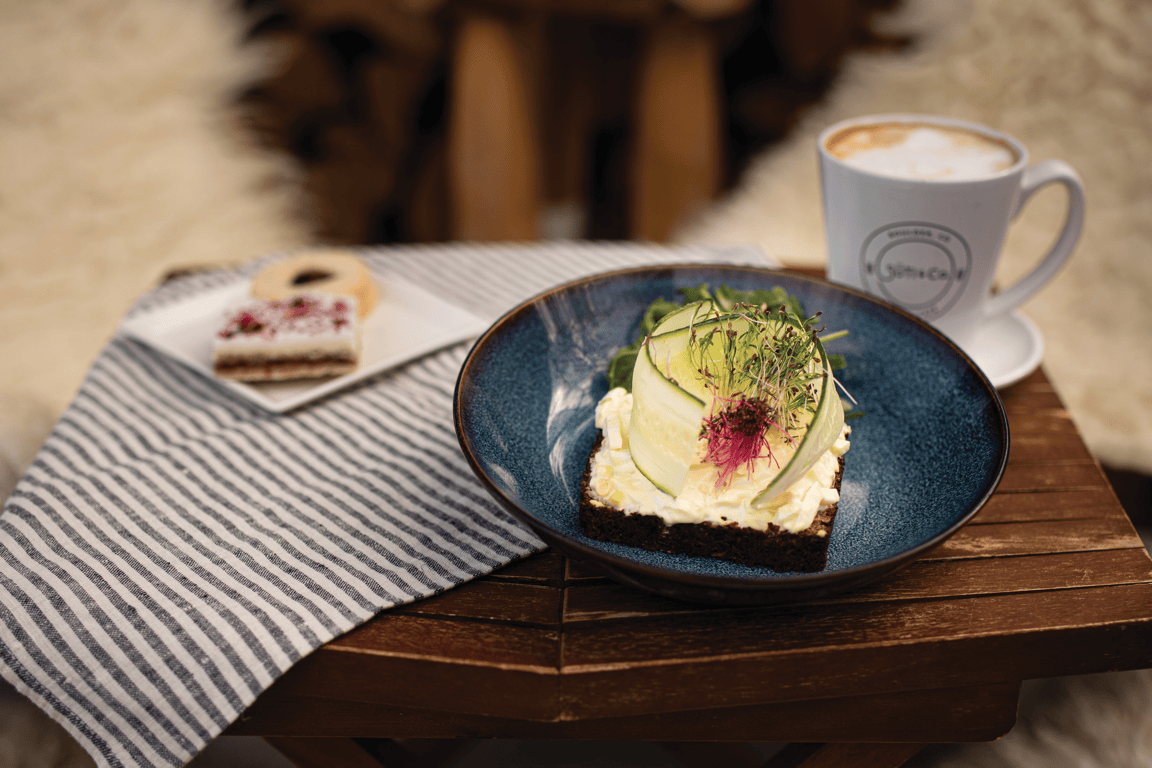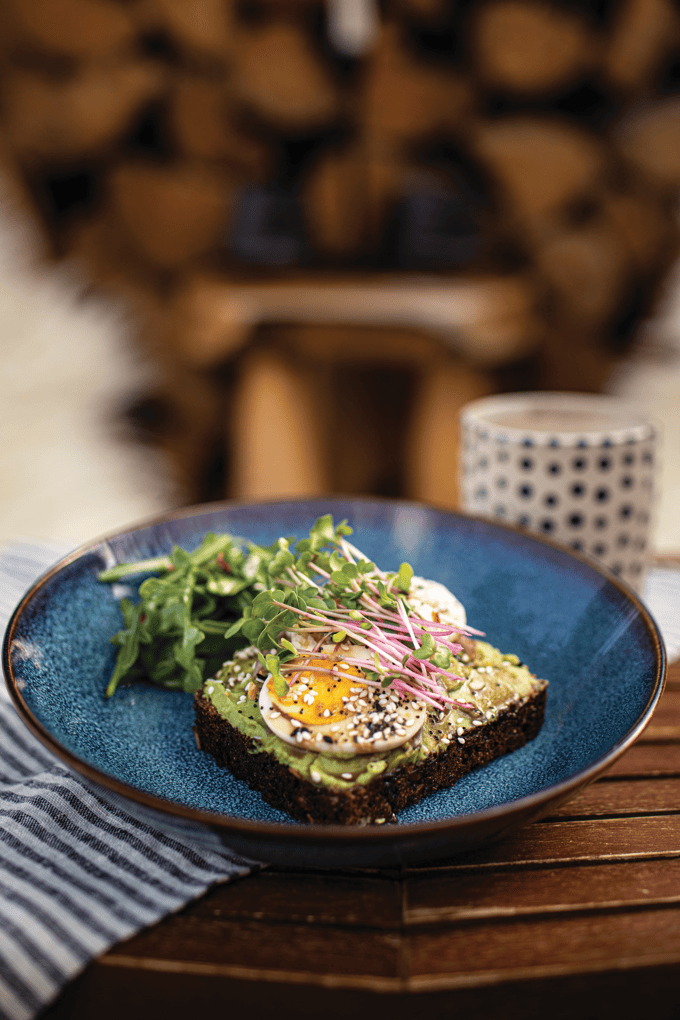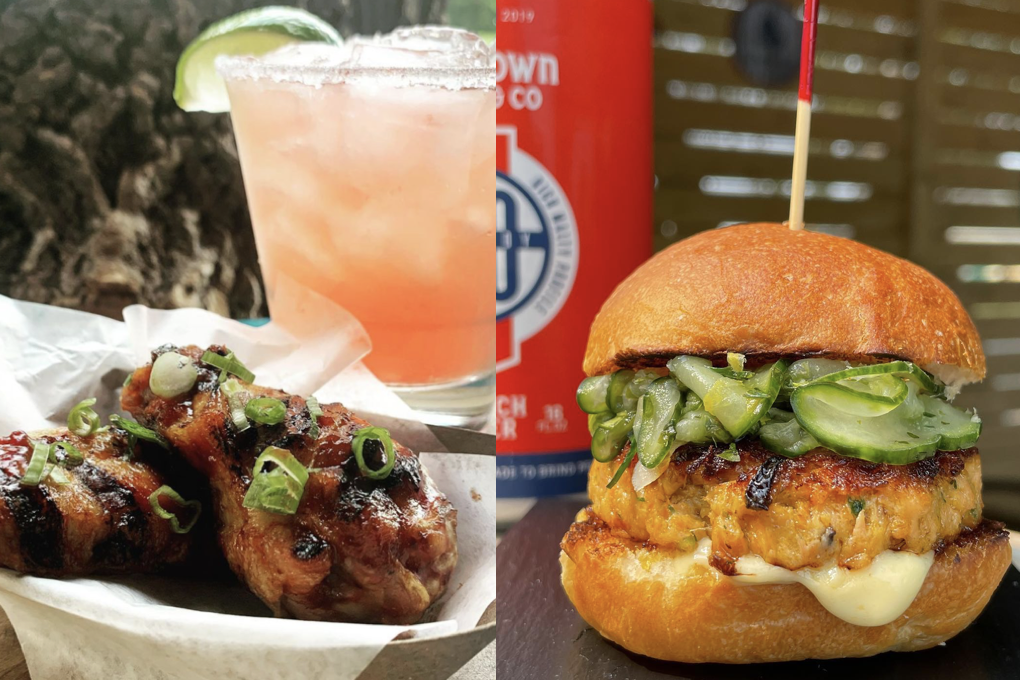
Diving Into Scandi Café Culture
The food, beverages and vibe all inspire modern menus
Diving Into Scandi Café Culture
The food, beverages and vibe all inspire modern menus
By Katie Ayoub
February 7, 2024
By Katie Ayoub
February 7, 2024
Like a breath of fresh air, Scandinavia is moving in and showing us how to slow down and savor. It’s bringing the Swedish concept of fika to life, creating spaces and menus that encourage American consumers to take a moment and enjoy a coffee, a treat, a savory bite—and each other’s company.
Scandi bar and café culture is spreading here. Its vibe is calming and welcoming, and its menu aesthetic lines up with many of today’s trends. Indeed, the overall sensibility casts a soft glow of opportunity, projecting the next evolution of warm hospitality. “This is what we’re striving for in hospitality today: offering an inviting experience that brings people together,” says Mindy Armstrong, VP of menu innovation at Ascent Hospitality Management, the parent company of Perkins Restaurant & Bakery. “At Perkins, we’re known for our bakery. Leveraging Scandi café culture offers us a great opportunity to create a moment in the day for friends to come in and have a piece of pie and warm cup of tea or coffee. It doesn’t have to be an over-the-top experience. This trend reminds us that it can be simple and genuine. We can look at interpreting fika for our brands as a way of forging deeper emotional connections with our guests.”
Wrapped up in the cozy aesthetic of Scandi bars and cafés is a menu rich with modern opportunity. “Scandinavian cuisine is like Mediterranean food for Northern Europe,” says Maeve Webster, president of Menu Matters consultancy. “Scandinavian countries highlight whole ingredients, their portions are on the smaller side, they incorporate a lot of produce, and they move with the seasons.”
We’ve seen Scandinavian and Nordic cuisines hovering on the fringes for years. What’s bringing Scandi bar culture to the forefront today? “Deeper entry into the U.S. market has been percolating for years, but it’s now poised for broader adoption,” says Webster. “One of the drivers is how much Scandinavia has been in the news over the last few years. For example, Sweden’s decision to join NATO gave the region greater prominence in American minds. There’s also the pop culture driver, reflecting the current popularity of Scandinavian Gothic crime shows on streaming services.” Perhaps the biggest driver that’s propelling the Scandinavian aesthetic into the spotlight is its cultural appeal. Happiness, well-being and contentment underpin the cuisine and culture. Consumers here are eager to explore that phenomenon.
“There’s so much that appeals about Scandi culture,” says Claire Conaghan, trendologist and associate director of publications, Datassential. “Their traditions of pickling, preserving and fermenting are interesting to chefs and consumers here. It’s a snack-focused culture with appealing drinks. Then there’s that togetherness, calm and taking time for yourself—all of which consumers crave today.”
 Photo Credit: George Lomas Photography on Instagram @glomasphotos
Photo Credit: George Lomas Photography on Instagram @glomasphotos Süti & Co. shows off a Scandi take on avo toast, with crushed avocado, house-pickled onions, organic hard-boiled egg slices, everything seasoning, balsamic reduction and micro radish.
It Starts With Fika
Fika is deeply ingrained in Swedish culture. It refers to the act of taking a break to enjoy coffee or tea with a pastry or snack. But it goes further than that. It’s a social activity that encourages people to pause and connect. It’s a daily ritual for many Swedes, and its sentiment carries throughout Scandinavia. Denmark’s hygge is closely related, translating to a sense of coziness and well-being. “What fika is to Sweden, hygge is to us,” says Andrea Uzarowski, who brings her family’s Danish recipes to Süti & Co., a Scandinavian-style café in Boulder, Colo., where she is chef/owner. “Both terms convey a sense of pleasure and happiness that come from simple things.”
The trend doesn’t dictate an overhaul of atmosphere in order to take advantage of its opportunities. Instead, Scandi bar culture offers a sensibility that can be translated, conveying at its core hospitality. “The focus of Scandinavian cafés, like ours at Süti & Co., is to create a space where you feel safe, cared for, loved and know that you matter,” says Uzarowski.
Taking cues from this aesthetic paves the way to modern hospitality. “I think the Scandi aesthetic fits very well with a lot of factors that resonate with consumers right now: calming, clean lines, soothing colors, nothing riotous or overwhelming,” says Webster.
Scandi Flavor Inspiration
The appealing vibe carries over into the cuisine with a built-in ease, approachability and warmth in both food and beverage offerings. Webster highlights a few key ingredients worth delving into. “They have a far stronger berry culture than what you typically find in the U.S., going beyond strawberries and blueberries. They also use lingonberries, cloud berries and elderberries, featuring them all in ways that could easily be adapted here in multiple applications, from savory soups and sauces to beverages,” she says. “Whole grains are big, with rye and buckwheat flours showing up a lot. With American consumers looking more to complex grains, this trend checks that box.”
 Photo Credit: Oskar’s Slider Bar
Photo Credit: Oskar’s Slider Bar Oskar’s Slider Bar in Louisville, Ky., brings out the fun side of the trend with items like Grilled Chicken Wings featuring a blueberry-chipotle barbecue sauce and a Smokeberry Margarita with smoked lingonberry syrup (left). The Smoked Salmon Fish Cake sandwich is topped with a Swedish cucumber salad and koji-preserved lemon aioli (right).
Oskar’s Slider Bar in Louisville, Ky., showcases the menu potential with its Scandi-inspired small bites that are a balance of playful, casual and craveable. The Pork Ribs are seasoned with “Scandi butt rub,” then are smoked and “Korean fried” and topped with a bilberry and blackberry sticky glaze. Its cocktail list is just as interesting, anchoring the menu with an aquavit flight, but including tamer options like a Smokeberry Margarita with mezcal, Tattersall orange créma, lime and smoked lingonberry syrup as well as a cocktail infused with black licorice, citrus, Einstök Toasted Porter beer syrup and Brennivín. Newport Coffee House, with two locations in Illinois, also shows how lingonberries can star on modern beverage menus, serving a Lingonberry Coffee Tonic among its offerings.
Broder, based in Portland, Ore., offers a shareable that follows in the tradition of a charcuterie board. Its Broder Bord stars house-cured gravlax, curried egg salad, chèvre, Havarti, beet-pickled egg, crackers, Nordic rye and a housemade granola parfait. Its Danish Mary easily slides into American brunch culture, thrilling diners with a new take on a classic with its sub of dill aquavit for vodka.
Süti & Co. menus the classic Scandinavian cardamom bun and highlights that warm spice’s flavor elsewhere on the menu, including the Cardamom-Orange Latte, another example of a familiar-yet-intriguing flavor combination that the American diner is primed to embrace. “Cardamom is such a staple flavor for us. I love the smell and taste of it, so I always try to find a way to work it into a new offering,” says Uzarowski. “Cardamom buns with pearl sugar always sell out shortly after the buns make it onto the counter. The spice finds its way into our shortbreads, too, along with white chocolate filling and rose petals, and it is used in our Love cake—a cardamom-olive oil cake with rosewater and pistachio glaze.”
Fika, a walk-up café and micro-bakery in Saco, Maine, features cardamom in its Cardamom Buckwheat Horchata, showing the ease in which Scandi cuisine mashes with global influences. Its Nordic Toast highlights the smørrebrød’s looser and broader translation into American menu development, starring brûléed pumpkin, house apple butter and pepitas on rye bread. “Smørrebrød, for American menu developers, is the next iteration of avocado toast, right?” says Armstrong. “How do you create this perfect template, this format, that you can then build on to make these moments? It’s about featuring super approachable menu items that pair well with a simple coffee, tea or glass of wine.” Süti’s smørrebrød menu, featuring Danish rye bread, includes classic toppings like egg salad and salmon, then branches into offerings like butternut squash and burrata.
Perhaps the greatest gift of the Scandi bar and café adaptation may be found in its philosophy, serving as a roadmap to evolved hospitality. “Scandinavian café culture focuses on the simplicity of the pleasure we get from having an espresso and a slice of cake or a shortbread,” says Uzarowski. “This allows us to create a more personal relationship with our guests.”
Like a breath of fresh air, Scandinavia is moving in and showing us how to slow down and savor. It’s bringing the Swedish concept of fika to life, creating spaces and menus that encourage American consumers to take a moment and enjoy a coffee, a treat, a savory bite—and each other’s company.
Scandi bar and café culture is spreading here. Its vibe is calming and welcoming, and its menu aesthetic lines up with many of today’s trends. Indeed, the overall sensibility casts a soft glow of opportunity, projecting the next evolution of warm hospitality. “This is what we’re striving for in hospitality today: offering an inviting experience that brings people together,” says Mindy Armstrong, VP of menu innovation at Ascent Hospitality Management, the parent company of Perkins Restaurant & Bakery. “At Perkins, we’re known for our bakery. Leveraging Scandi café culture offers us a great opportunity to create a moment in the day for friends to come in and have a piece of pie and warm cup of tea or coffee. It doesn’t have to be an over-the-top experience. This trend reminds us that it can be simple and genuine. We can look at interpreting fika for our brands as a way of forging deeper emotional connections with our guests.”
Wrapped up in the cozy aesthetic of Scandi bars and cafés is a menu rich with modern opportunity. “Scandinavian cuisine is like Mediterranean food for Northern Europe,” says Maeve Webster, president of Menu Matters consultancy. “Scandinavian countries highlight whole ingredients, their portions are on the smaller side, they incorporate a lot of produce, and they move with the seasons.”
We’ve seen Scandinavian and Nordic cuisines hovering on the fringes for years. What’s bringing Scandi bar culture to the forefront today? “Deeper entry into the U.S. market has been percolating for years, but it’s now poised for broader adoption,” says Webster. “One of the drivers is how much Scandinavia has been in the news over the last few years. For example, Sweden’s decision to join NATO gave the region greater prominence in American minds. There’s also the pop culture driver, reflecting the current popularity of Scandinavian Gothic crime shows on streaming services.” Perhaps the biggest driver that’s propelling the Scandinavian aesthetic into the spotlight is its cultural appeal. Happiness, well-being and contentment underpin the cuisine and culture. Consumers here are eager to explore that phenomenon.
“There’s so much that appeals about Scandi culture,” says Claire Conaghan, trendologist and associate director of publications, Datassential. “Their traditions of pickling, preserving and fermenting are interesting to chefs and consumers here. It’s a snack-focused culture with appealing drinks. Then there’s that togetherness, calm and taking time for yourself—all of which consumers crave today.”
 Photo Credit: George Lomas Photography on Instagram @glomasphotos
Photo Credit: George Lomas Photography on Instagram @glomasphotos Süti & Co. shows off a Scandi take on avo toast, with crushed avocado, house-pickled onions, organic hard-boiled egg slices, everything seasoning, balsamic reduction and micro radish.
It Starts With Fika
Fika is deeply ingrained in Swedish culture. It refers to the act of taking a break to enjoy coffee or tea with a pastry or snack. But it goes further than that. It’s a social activity that encourages people to pause and connect. It’s a daily ritual for many Swedes, and its sentiment carries throughout Scandinavia. Denmark’s hygge is closely related, translating to a sense of coziness and well-being. “What fika is to Sweden, hygge is to us,” says Andrea Uzarowski, who brings her family’s Danish recipes to Süti & Co., a Scandinavian-style café in Boulder, Colo., where she is chef/owner. “Both terms convey a sense of pleasure and happiness that come from simple things.”
The trend doesn’t dictate an overhaul of atmosphere in order to take advantage of its opportunities. Instead, Scandi bar culture offers a sensibility that can be translated, conveying at its core hospitality. “The focus of Scandinavian cafés, like ours at Süti & Co., is to create a space where you feel safe, cared for, loved and know that you matter,” says Uzarowski.
Taking cues from this aesthetic paves the way to modern hospitality. “I think the Scandi aesthetic fits very well with a lot of factors that resonate with consumers right now: calming, clean lines, soothing colors, nothing riotous or overwhelming,” says Webster.
Scandi Flavor Inspiration
The appealing vibe carries over into the cuisine with a built-in ease, approachability and warmth in both food and beverage offerings. Webster highlights a few key ingredients worth delving into. “They have a far stronger berry culture than what you typically find in the U.S., going beyond strawberries and blueberries. They also use lingonberries, cloud berries and elderberries, featuring them all in ways that could easily be adapted here in multiple applications, from savory soups and sauces to beverages,” she says. “Whole grains are big, with rye and buckwheat flours showing up a lot. With American consumers looking more to complex grains, this trend checks that box.”
 Photo Credit: Oskar’s Slider Bar
Photo Credit: Oskar’s Slider Bar Oskar’s Slider Bar in Louisville, Ky., brings out the fun side of the trend with items like Grilled Chicken Wings featuring a blueberry-chipotle barbecue sauce and a Smokeberry Margarita with smoked lingonberry syrup (left). The Smoked Salmon Fish Cake sandwich is topped with a Swedish cucumber salad and koji-preserved lemon aioli (right).
Oskar’s Slider Bar in Louisville, Ky., showcases the menu potential with its Scandi-inspired small bites that are a balance of playful, casual and craveable. The Pork Ribs are seasoned with “Scandi butt rub,” then are smoked and “Korean fried” and topped with a bilberry and blackberry sticky glaze. Its cocktail list is just as interesting, anchoring the menu with an aquavit flight, but including tamer options like a Smokeberry Margarita with mezcal, Tattersall orange créma, lime and smoked lingonberry syrup as well as a cocktail infused with black licorice, citrus, Einstök Toasted Porter beer syrup and Brennivín. Newport Coffee House, with two locations in Illinois, also shows how lingonberries can star on modern beverage menus, serving a Lingonberry Coffee Tonic among its offerings.
Broder, based in Portland, Ore., offers a shareable that follows in the tradition of a charcuterie board. Its Broder Bord stars house-cured gravlax, curried egg salad, chèvre, Havarti, beet-pickled egg, crackers, Nordic rye and a housemade granola parfait. Its Danish Mary easily slides into American brunch culture, thrilling diners with a new take on a classic with its sub of dill aquavit for vodka.
Süti & Co. menus the classic Scandinavian cardamom bun and highlights that warm spice’s flavor elsewhere on the menu, including the Cardamom-Orange Latte, another example of a familiar-yet-intriguing flavor combination that the American diner is primed to embrace. “Cardamom is such a staple flavor for us. I love the smell and taste of it, so I always try to find a way to work it into a new offering,” says Uzarowski. “Cardamom buns with pearl sugar always sell out shortly after the buns make it onto the counter. The spice finds its way into our shortbreads, too, along with white chocolate filling and rose petals, and it is used in our Love cake—a cardamom-olive oil cake with rosewater and pistachio glaze.”
Fika, a walk-up café and micro-bakery in Saco, Maine, features cardamom in its Cardamom Buckwheat Horchata, showing the ease in which Scandi cuisine mashes with global influences. Its Nordic Toast highlights the smørrebrød’s looser and broader translation into American menu development, starring brûléed pumpkin, house apple butter and pepitas on rye bread. “Smørrebrød, for American menu developers, is the next iteration of avocado toast, right?” says Armstrong. “How do you create this perfect template, this format, that you can then build on to make these moments? It’s about featuring super approachable menu items that pair well with a simple coffee, tea or glass of wine.” Süti’s smørrebrød menu, featuring Danish rye bread, includes classic toppings like egg salad and salmon, then branches into offerings like butternut squash and burrata.
Perhaps the greatest gift of the Scandi bar and café adaptation may be found in its philosophy, serving as a roadmap to evolved hospitality. “Scandinavian café culture focuses on the simplicity of the pleasure we get from having an espresso and a slice of cake or a shortbread,” says Uzarowski. “This allows us to create a more personal relationship with our guests.”
About the Author
![]() Katie Ayoub serves as managing editor of Flavor & The Menu and content strategist for the Flavor Experience, an annual conference geared toward chain operators. She is president of Katie Ayoub & Associates, serving up menu trends expertise, content creation and food & beverage consultancy. Based in Chicago, Katie has been working in foodservice publishing for more than 20 years and part of the Flavor team since 2006. [email protected]
Katie Ayoub serves as managing editor of Flavor & The Menu and content strategist for the Flavor Experience, an annual conference geared toward chain operators. She is president of Katie Ayoub & Associates, serving up menu trends expertise, content creation and food & beverage consultancy. Based in Chicago, Katie has been working in foodservice publishing for more than 20 years and part of the Flavor team since 2006. [email protected]







